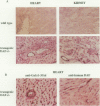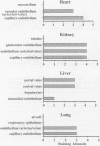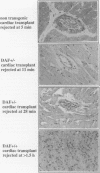Abstract
BACKGROUND: Production of transgenic pigs for multiple transgenes is part of a potential strategy to prevent immunological events involved in xenograft rejection. Use of a genetically engineerable rodent as a donor in primates could allow testing in vivo of the effects of different transgenes on controlling xenograft rejection. As a first step in the development of a donor containing multiple transgenes, transgenic rats for human decay-accelerating factor (DAF) were used as heart donors to test their resistance against complement (C)-mediated rejection by non-human primates. MATERIALS AND METHODS: Transgenic rats were generated by using a construct containing the human DAF cDNA under the transcriptional control of the endothelial cell (EC)-specific human ICAM-2 promoter. DAF expression was evaluated by immunohistology and by FACS analysis of purified ECs. Resistance of transgenic hearts against C-mediated damage was evaluated by ex vivo perfusion with human serum and by transplantation into cynomolgus monkeys. RESULTS: Immunohistological analysis of DAF expression in several organs from two transgenic lines showed uniform expression on the endothelium of all blood vessels. ECs purified from transgenic hearts showed 50% DAF expression compared to human ECs and >70% reduction of C-dependent cell lysis compared to control rat ECs. Hemizygous transgenic hearts perfused with human serum showed normal function for >60 min vs. 11. 2 +/- 1.7 min in controls. Hemi- or homozygous transgenic hearts transplanted into cynomolgus monkeys showed longer survival (15.2 +/- 7 min and >4.5 hr, respectively) than controls (5.5 +/- 1.4 min). In contrast to hyperacutely rejected control hearts, rejected homozygous DAF hearts showed signs of acute vascular rejection (AVR) characterized by edema, hemorrhage, and an intense PMN infiltration. CONCLUSIONS: We demonstrate that endothelial-specific DAF expression increased heart transplant survival in a rat-to-primate model of xenotransplantation. This will aid in the analysis of AVR and of new genes that may inhibit this form of rejection, thus helping to define strategies for the production of transgenic pigs.
Full text
PDF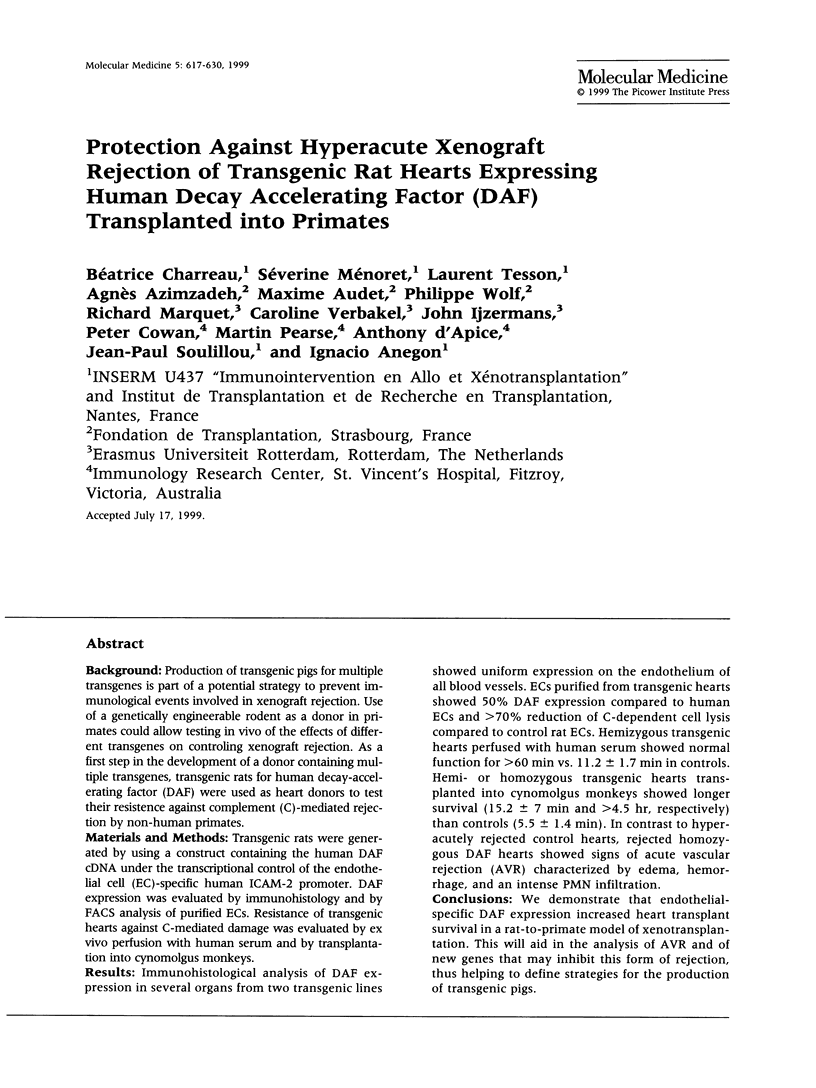
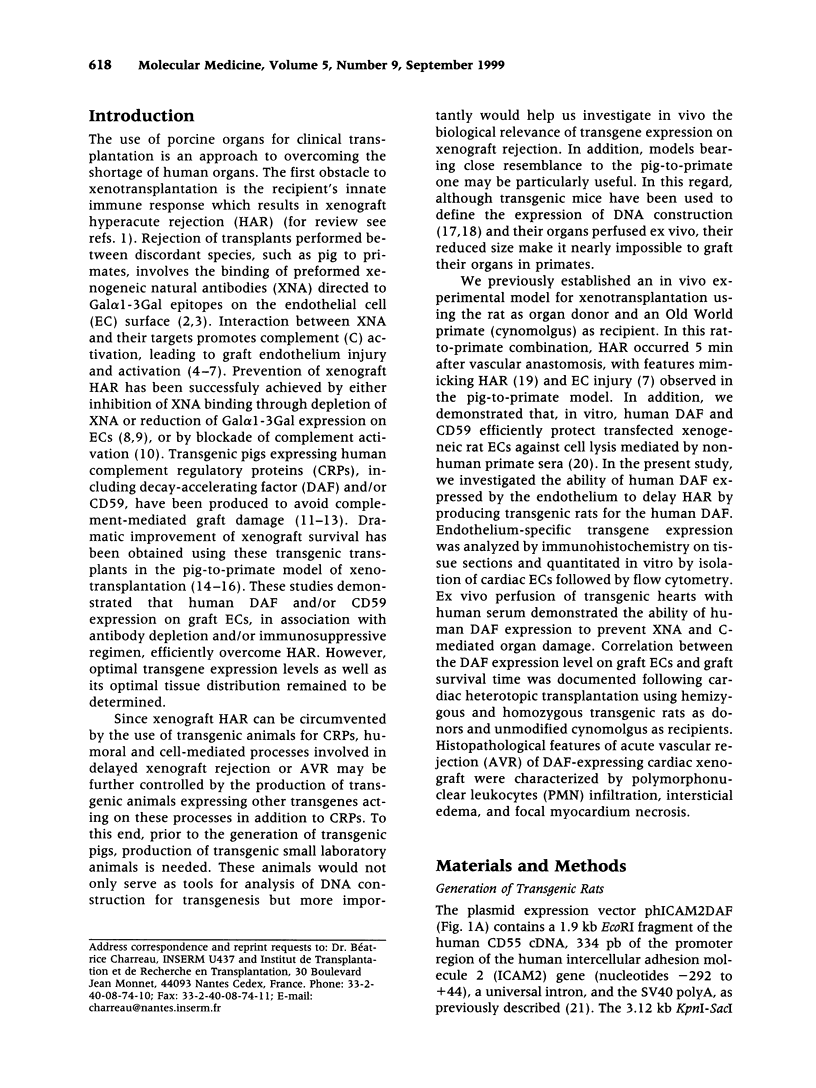
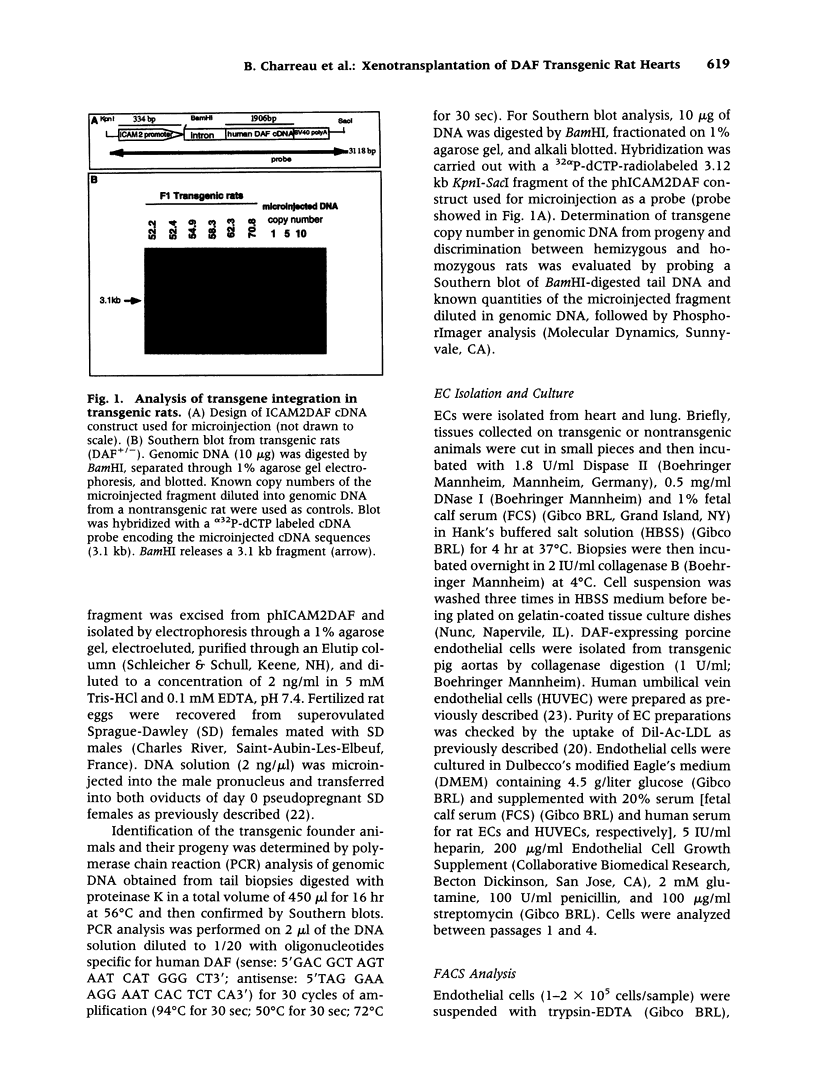
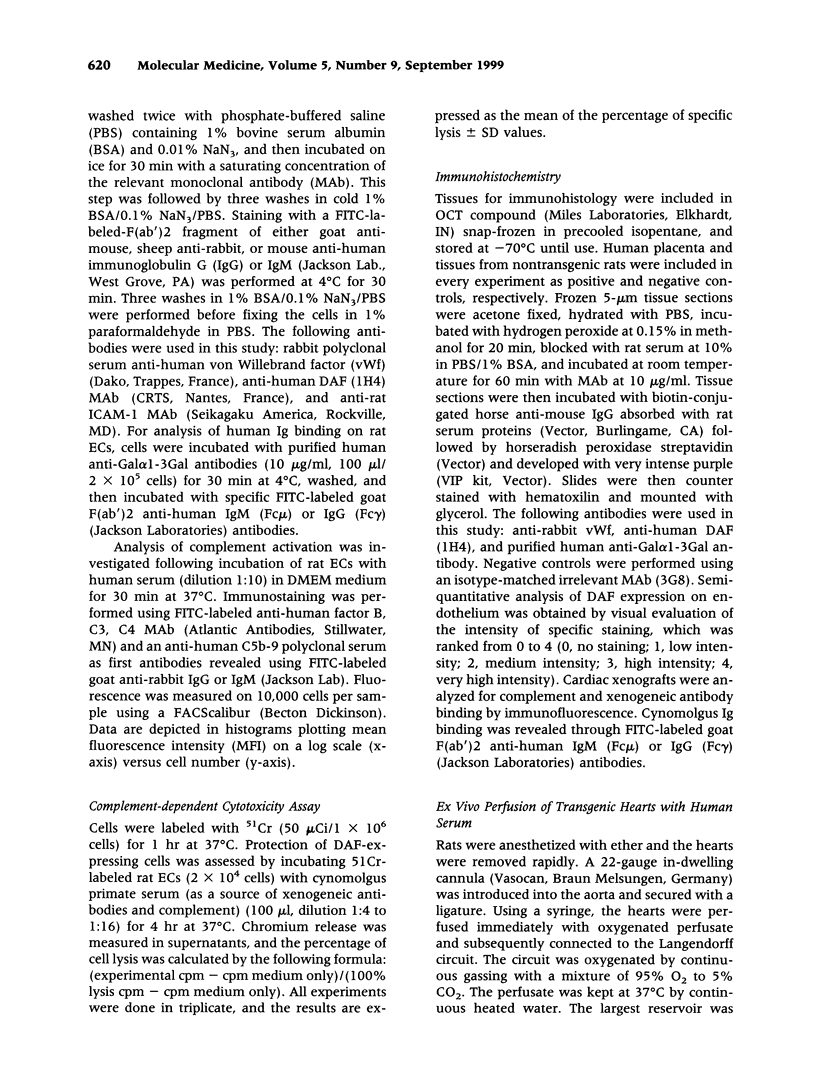
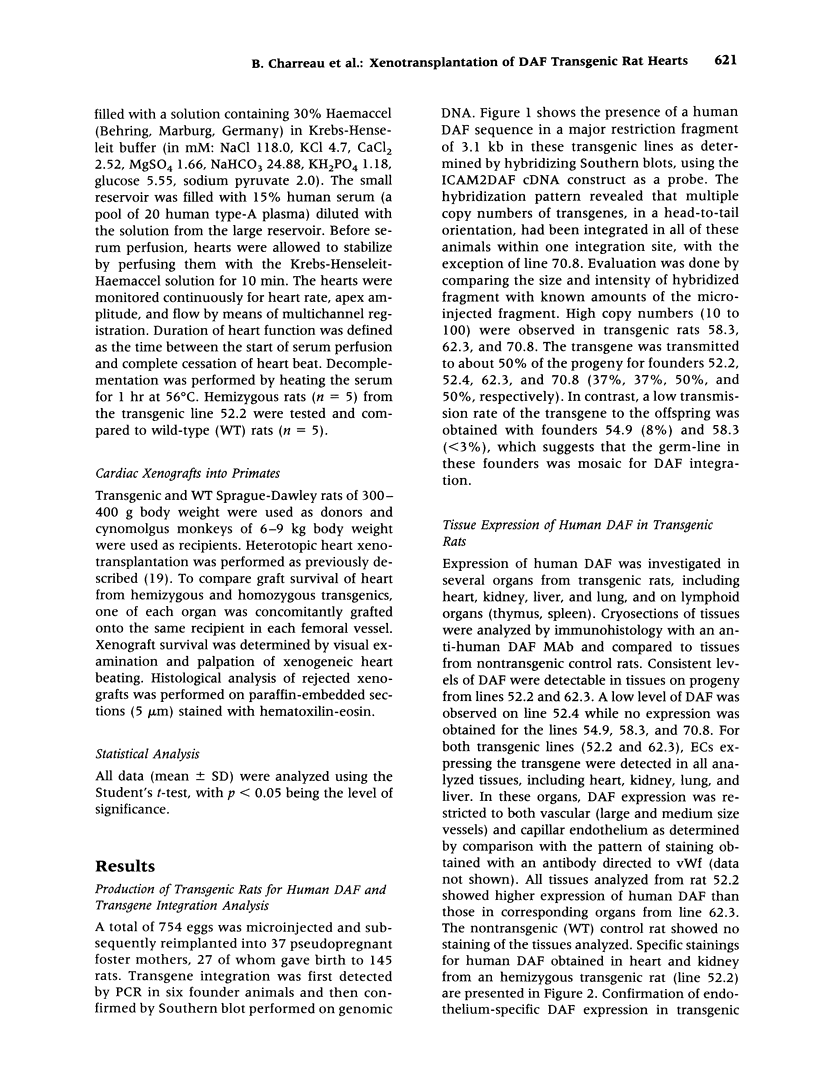
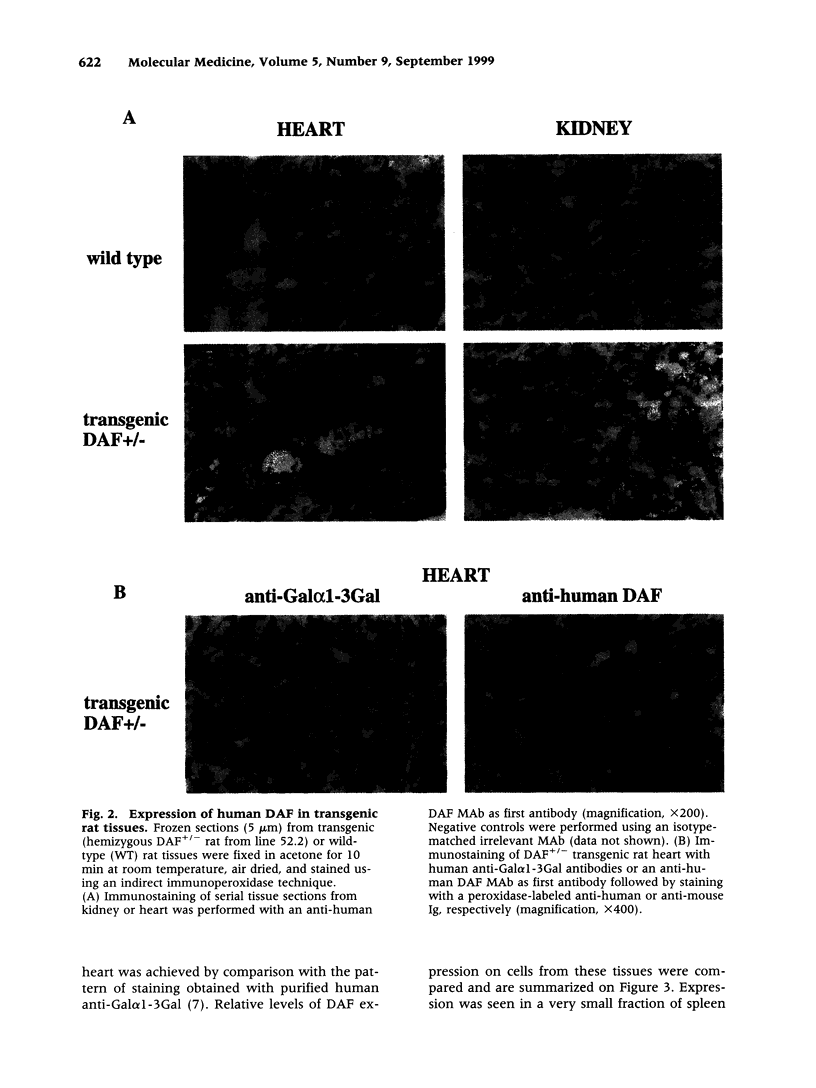
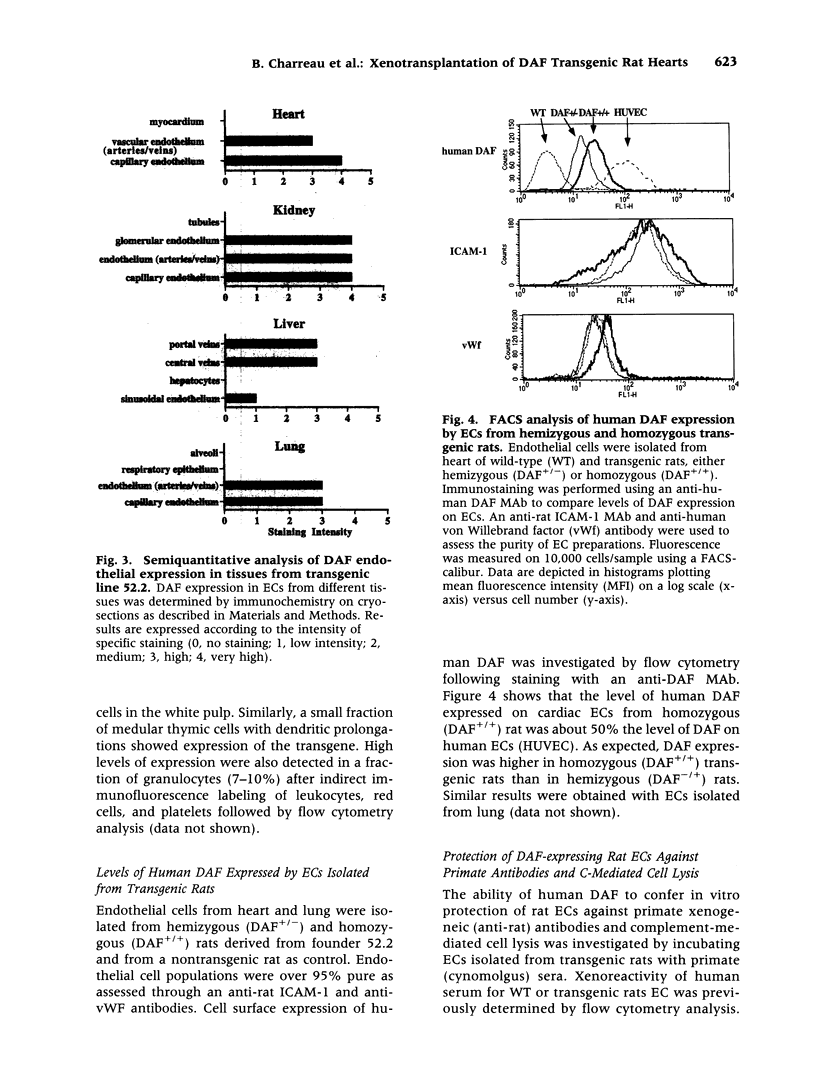
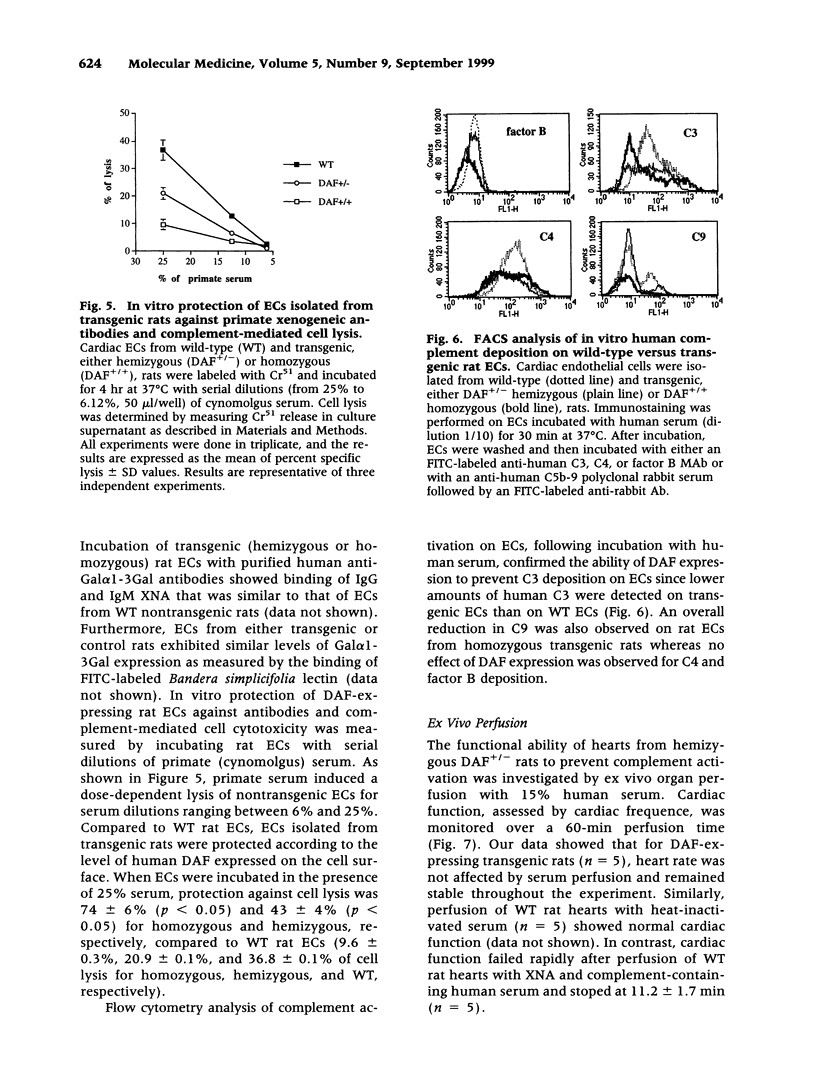
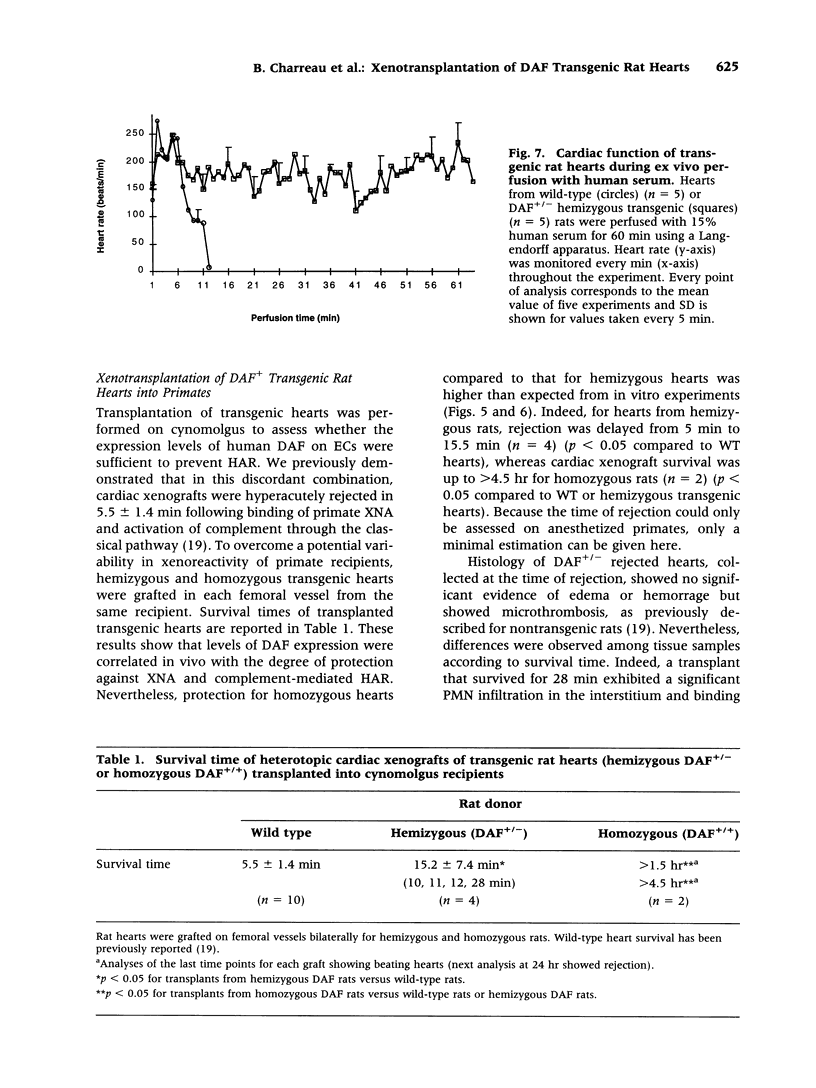
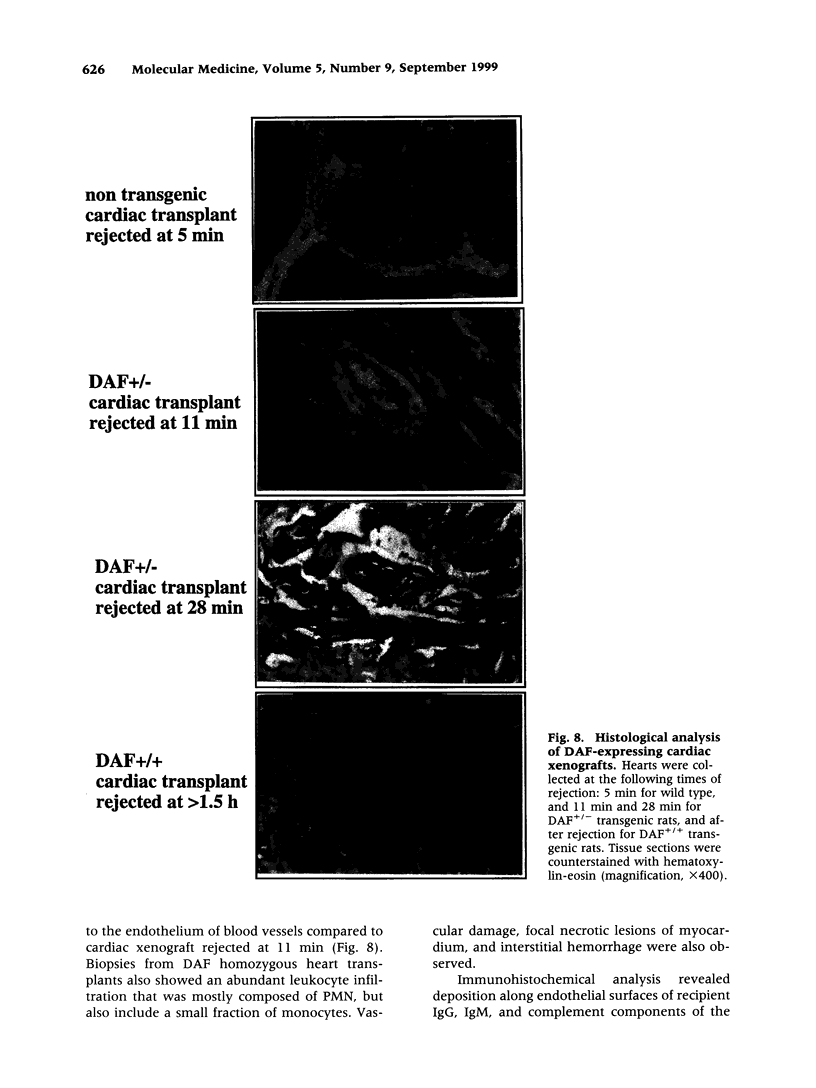
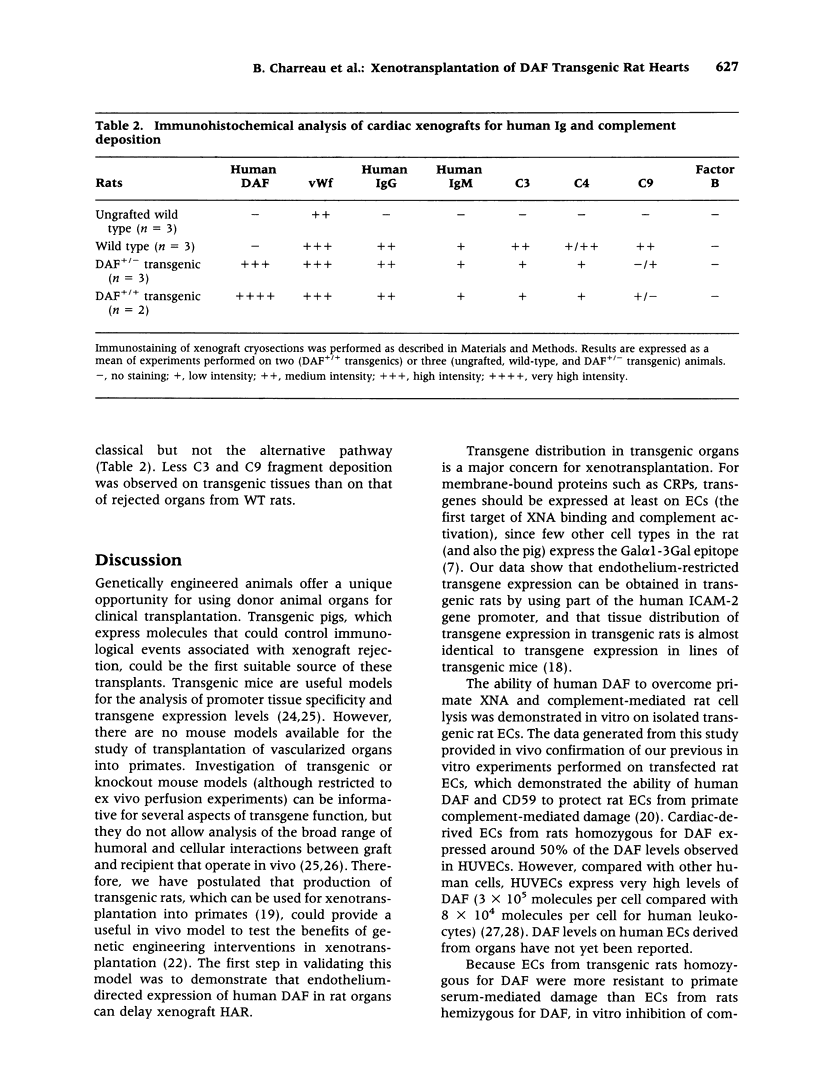
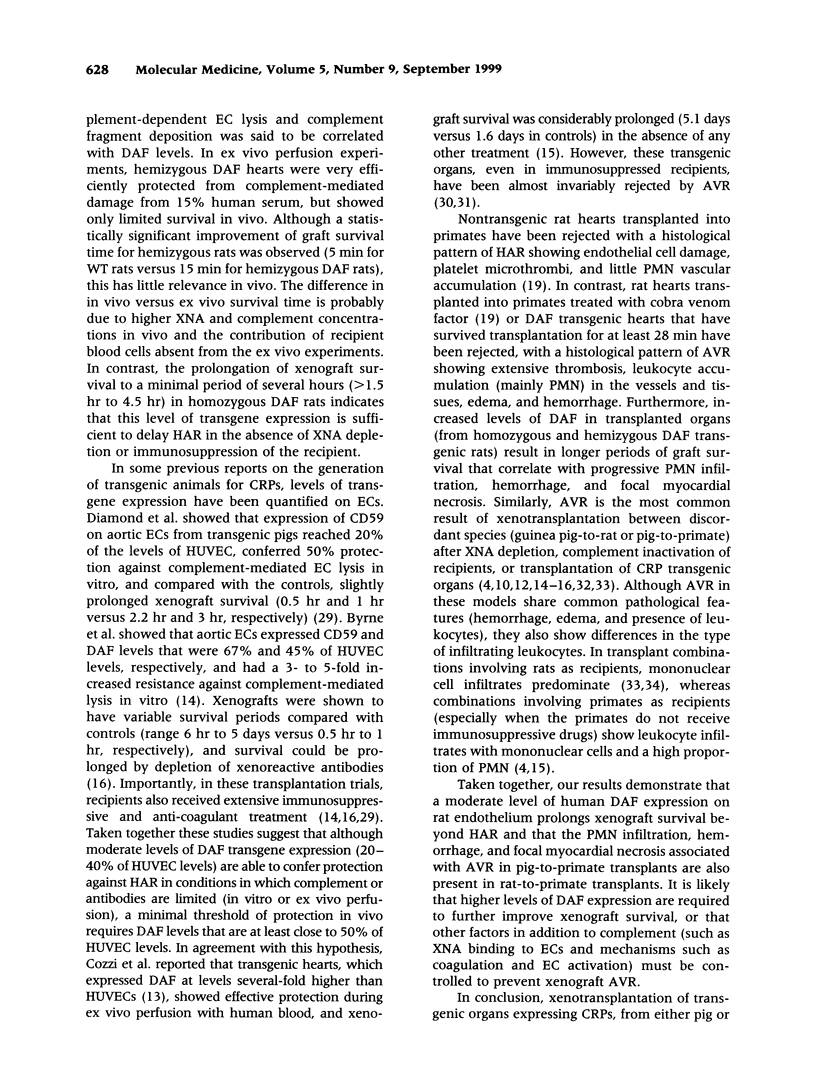
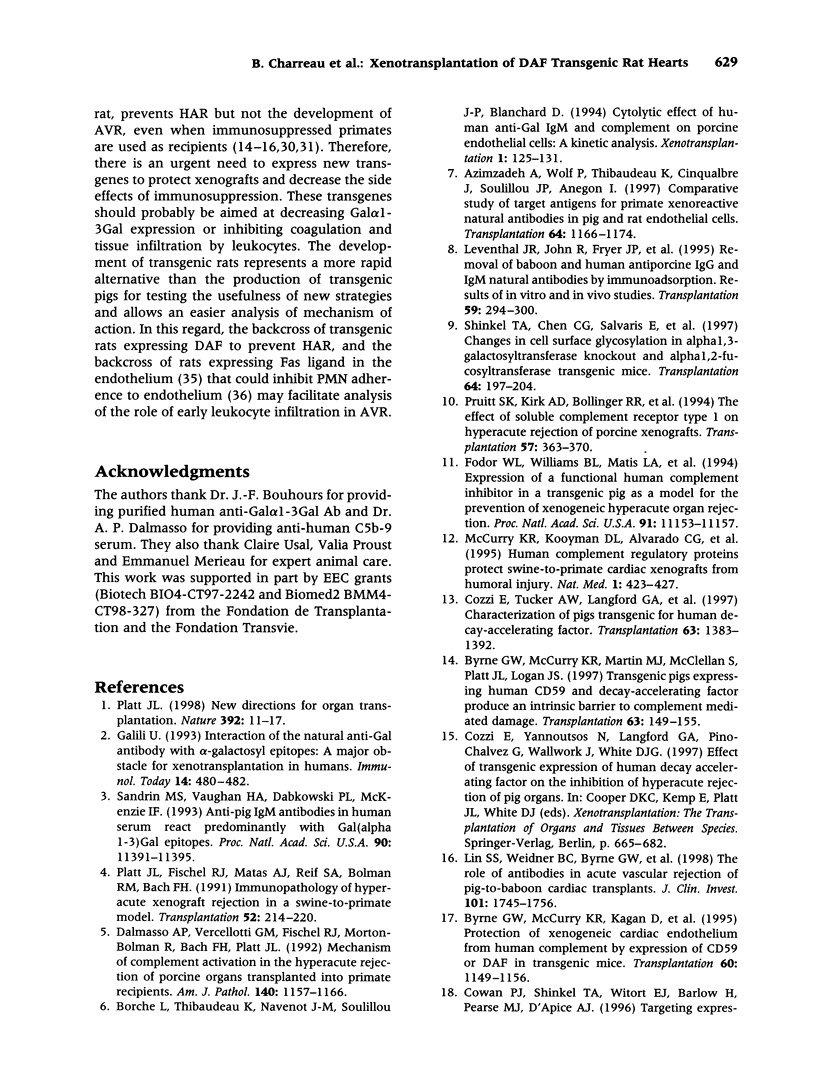
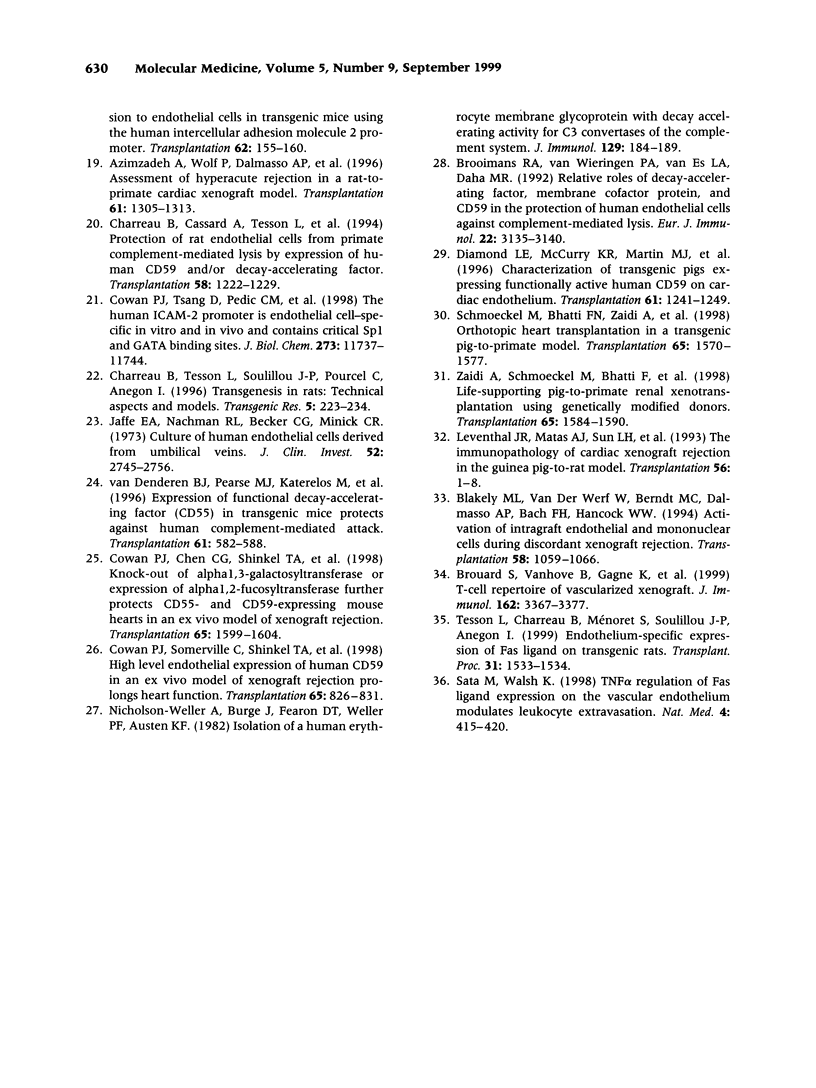
Images in this article
Selected References
These references are in PubMed. This may not be the complete list of references from this article.
- Azimzadeh A., Wolf P., Dalmasso A. P., Odeh M., Beller J. P., Fabre M., Charreau B., Thibaudeau K., Cinqualbre J., Soulillou J. P. Assessment of hyperacute rejection in a rat-to-primate cardiac xenograft model. Transplantation. 1996 May 15;61(9):1305–1313. doi: 10.1097/00007890-199605150-00004. [DOI] [PubMed] [Google Scholar]
- Azimzadeh A., Wolf P., Thibaudeau K., Cinqualbre J., Soulillou J. P., Anegon I. Comparative study of target antigens for primate xenoreactive natural antibodies in pig and rat endothelial cells. Transplantation. 1997 Oct 27;64(8):1166–1174. doi: 10.1097/00007890-199710270-00015. [DOI] [PubMed] [Google Scholar]
- Blakely M. L., Van der Werf W. J., Berndt M. C., Dalmasso A. P., Bach F. H., Hancock W. W. Activation of intragraft endothelial and mononuclear cells during discordant xenograft rejection. Transplantation. 1994 Nov 27;58(10):1059–1066. [PubMed] [Google Scholar]
- Brooimans R. A., van Wieringen P. A., van Es L. A., Daha M. R. Relative roles of decay-accelerating factor, membrane cofactor protein, and CD59 in the protection of human endothelial cells against complement-mediated lysis. Eur J Immunol. 1992 Dec;22(12):3135–3140. doi: 10.1002/eji.1830221216. [DOI] [PubMed] [Google Scholar]
- Brouard S., Vanhove B., Gagne K., Neumann A., Douillard P., Moreau A., Cuturi C., Soulillou J. P. T cell repertoire alterations of vascularized xenografts. J Immunol. 1999 Mar 15;162(6):3367–3377. [PubMed] [Google Scholar]
- Byrne G. W., McCurry K. R., Kagan D., Quinn C., Martin M. J., Platt J. L., Logan J. S. Protection of xenogeneic cardiac endothelium from human complement by expression of CD59 or DAF in transgenic mice. Transplantation. 1995 Nov 27;60(10):1149–1156. doi: 10.1097/00007890-199511270-00016. [DOI] [PubMed] [Google Scholar]
- Byrne G. W., McCurry K. R., Martin M. J., McClellan S. M., Platt J. L., Logan J. S. Transgenic pigs expressing human CD59 and decay-accelerating factor produce an intrinsic barrier to complement-mediated damage. Transplantation. 1997 Jan 15;63(1):149–155. doi: 10.1097/00007890-199701150-00027. [DOI] [PubMed] [Google Scholar]
- Charreau B., Cassard A., Tesson L., Le Mauff B., Navenot J. M., Blanchard D., Lublin D., Soulillou J. P., Anegon I. Protection of rat endothelial cells from primate complement-mediated lysis by expression of human CD59 and/or decay-accelerating factor. Transplantation. 1994 Dec 15;58(11):1222–1229. [PubMed] [Google Scholar]
- Charreau B., Tesson L., Soulillou J. P., Pourcel C., Anegon I. Transgenesis in rats: technical aspects and models. Transgenic Res. 1996 Jul;5(4):223–234. doi: 10.1007/BF01972876. [DOI] [PubMed] [Google Scholar]
- Cowan P. J., Chen C. G., Shinkel T. A., Fisicaro N., Salvaris E., Aminian A., Romanella M., Pearse M. J., d'Apice A. J. Knock out of alpha1,3-galactosyltransferase or expression of alpha1,2-fucosyltransferase further protects CD55- and CD59-expressing mouse hearts in an ex vivo model of xenograft rejection. Transplantation. 1998 Jun 27;65(12):1599–1604. doi: 10.1097/00007890-199806270-00010. [DOI] [PubMed] [Google Scholar]
- Cowan P. J., Somerville C. A., Shinkel T. A., Katerelos M., Aminian A., Romanella M., Tange M. J., Pearse M. J., d'Apice A. J. High-level endothelial expression of human CD59 prolongs heart function in an ex vivo model of xenograft rejection. Transplantation. 1998 Mar 27;65(6):826–831. doi: 10.1097/00007890-199803270-00010. [DOI] [PubMed] [Google Scholar]
- Cowan P. J., Tsang D., Pedic C. M., Abbott L. R., Shinkel T. A., d'Apice A. J., Pearse M. J. The human ICAM-2 promoter is endothelial cell-specific in vitro and in vivo and contains critical Sp1 and GATA binding sites. J Biol Chem. 1998 May 8;273(19):11737–11744. doi: 10.1074/jbc.273.19.11737. [DOI] [PubMed] [Google Scholar]
- Cozzi E., Tucker A. W., Langford G. A., Pino-Chavez G., Wright L., O'Connell M. J., Young V. J., Lancaster R., McLaughlin M., Hunt K. Characterization of pigs transgenic for human decay-accelerating factor. Transplantation. 1997 Nov 27;64(10):1383–1392. doi: 10.1097/00007890-199711270-00002. [DOI] [PubMed] [Google Scholar]
- Dalmasso A. P., Vercellotti G. M., Fischel R. J., Bolman R. M., Bach F. H., Platt J. L. Mechanism of complement activation in the hyperacute rejection of porcine organs transplanted into primate recipients. Am J Pathol. 1992 May;140(5):1157–1166. [PMC free article] [PubMed] [Google Scholar]
- Diamond L. E., McCurry K. R., Martin M. J., McClellan S. B., Oldham E. R., Platt J. L., Logan J. S. Characterization of transgenic pigs expressing functionally active human CD59 on cardiac endothelium. Transplantation. 1996 Apr 27;61(8):1241–1249. doi: 10.1097/00007890-199604270-00021. [DOI] [PubMed] [Google Scholar]
- Fodor W. L., Williams B. L., Matis L. A., Madri J. A., Rollins S. A., Knight J. W., Velander W., Squinto S. P. Expression of a functional human complement inhibitor in a transgenic pig as a model for the prevention of xenogeneic hyperacute organ rejection. Proc Natl Acad Sci U S A. 1994 Nov 8;91(23):11153–11157. doi: 10.1073/pnas.91.23.11153. [DOI] [PMC free article] [PubMed] [Google Scholar]
- Galili U. Interaction of the natural anti-Gal antibody with alpha-galactosyl epitopes: a major obstacle for xenotransplantation in humans. Immunol Today. 1993 Oct;14(10):480–482. doi: 10.1016/0167-5699(93)90261-i. [DOI] [PubMed] [Google Scholar]
- Jaffe E. A., Nachman R. L., Becker C. G., Minick C. R. Culture of human endothelial cells derived from umbilical veins. Identification by morphologic and immunologic criteria. J Clin Invest. 1973 Nov;52(11):2745–2756. doi: 10.1172/JCI107470. [DOI] [PMC free article] [PubMed] [Google Scholar]
- Leventhal J. R., John R., Fryer J. P., Witson J. C., Derlich J. M., Remiszewski J., Dalmasso A. P., Matas A. J., Bolman R. M., 3rd Removal of baboon and human antiporcine IgG and IgM natural antibodies by immunoadsorption. Results of in vitro and in vivo studies. Transplantation. 1995 Jan 27;59(2):294–300. [PubMed] [Google Scholar]
- Lin S. S., Weidner B. C., Byrne G. W., Diamond L. E., Lawson J. H., Hoopes C. W., Daniels L. J., Daggett C. W., Parker W., Harland R. C. The role of antibodies in acute vascular rejection of pig-to-baboon cardiac transplants. J Clin Invest. 1998 Apr 15;101(8):1745–1756. doi: 10.1172/JCI2134. [DOI] [PMC free article] [PubMed] [Google Scholar]
- McCurry K. R., Kooyman D. L., Alvarado C. G., Cotterell A. H., Martin M. J., Logan J. S., Platt J. L. Human complement regulatory proteins protect swine-to-primate cardiac xenografts from humoral injury. Nat Med. 1995 May;1(5):423–427. doi: 10.1038/nm0595-423. [DOI] [PubMed] [Google Scholar]
- Nicholson-Weller A., Burge J., Fearon D. T., Weller P. F., Austen K. F. Isolation of a human erythrocyte membrane glycoprotein with decay-accelerating activity for C3 convertases of the complement system. J Immunol. 1982 Jul;129(1):184–189. [PubMed] [Google Scholar]
- Platt J. L., Fischel R. J., Matas A. J., Reif S. A., Bolman R. M., Bach F. H. Immunopathology of hyperacute xenograft rejection in a swine-to-primate model. Transplantation. 1991 Aug;52(2):214–220. doi: 10.1097/00007890-199108000-00006. [DOI] [PubMed] [Google Scholar]
- Platt J. L. New directions for organ transplantation. Nature. 1998 Apr 30;392(6679 Suppl):11–17. doi: 10.1038/32023. [DOI] [PubMed] [Google Scholar]
- Pruitt S. K., Kirk A. D., Bollinger R. R., Marsh H. C., Jr, Collins B. H., Levin J. L., Mault J. R., Heinle J. S., Ibrahim S., Rudolph A. R. The effect of soluble complement receptor type 1 on hyperacute rejection of porcine xenografts. Transplantation. 1994 Feb;57(3):363–370. doi: 10.1097/00007890-199402150-00009. [DOI] [PubMed] [Google Scholar]
- Sandrin M. S., Vaughan H. A., Dabkowski P. L., McKenzie I. F. Anti-pig IgM antibodies in human serum react predominantly with Gal(alpha 1-3)Gal epitopes. Proc Natl Acad Sci U S A. 1993 Dec 1;90(23):11391–11395. doi: 10.1073/pnas.90.23.11391. [DOI] [PMC free article] [PubMed] [Google Scholar]
- Sata M., Walsh K. TNFalpha regulation of Fas ligand expression on the vascular endothelium modulates leukocyte extravasation. Nat Med. 1998 Apr;4(4):415–420. doi: 10.1038/nm0498-415. [DOI] [PMC free article] [PubMed] [Google Scholar]
- Schmoeckel M., Bhatti F. N., Zaidi A., Cozzi E., Waterworth P. D., Tolan M. J., Pino-Chavez G., Goddard M., Warner R. G., Langford G. A. Orthotopic heart transplantation in a transgenic pig-to-primate model. Transplantation. 1998 Jun 27;65(12):1570–1577. doi: 10.1097/00007890-199806270-00006. [DOI] [PubMed] [Google Scholar]
- Shinkel T. A., Chen C. G., Salvaris E., Henion T. R., Barlow H., Galili U., Pearse M. J., d'Apice A. J. Changes in cell surface glycosylation in alpha1,3-galactosyltransferase knockout and alpha1,2-fucosyltransferase transgenic mice. Transplantation. 1997 Jul 27;64(2):197–204. doi: 10.1097/00007890-199707270-00003. [DOI] [PubMed] [Google Scholar]
- Tesson L., Charreau B., Ménoret S., Gilbert E., Soulillou J. P., Anegon I. Endothelial expression of Fas ligand in transgenic rats under the temporal control of a tetracycline-inducible system. Transplant Proc. 1999 May;31(3):1533–1534. doi: 10.1016/s0041-1345(99)00028-7. [DOI] [PubMed] [Google Scholar]
- Zaidi A., Schmoeckel M., Bhatti F., Waterworth P., Tolan M., Cozzi E., Chavez G., Langford G., Thiru S., Wallwork J. Life-supporting pig-to-primate renal xenotransplantation using genetically modified donors. Transplantation. 1998 Jun 27;65(12):1584–1590. doi: 10.1097/00007890-199806270-00008. [DOI] [PubMed] [Google Scholar]
- van Denderen B. J., Pearse M. J., Katerelos M., Nottle M. B., Du Z. T., Aminian A., Adam W. R., Shenoy-Scaria A., Lublin D. M., Shinkel T. A. Expression of functional decay-accelerating factor (CD55) in transgenic mice protects against human complement-mediated attack. Transplantation. 1996 Feb 27;61(4):582–588. doi: 10.1097/00007890-199602270-00012. [DOI] [PubMed] [Google Scholar]




